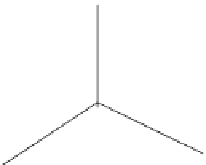Geoscience Reference
In-Depth Information
Solids
discharge
zone
Drying
zone
Conveyor
Solids pickup
zone
Sludge vat
FIGURE 24.10
Vacuum Filter.
■
EXAMPLE 24.123
Problem:
Digested biosolids are applied to a vacuum filter at a rate of 70 gpm, with a solids concen-
tration of 3%. If the vacuum filter has a surface area of 300 ft
2
, what is the filter loading in lb/hr/ft
2
?
Solution:
Biosolids(
gpm)60min/hr
×
×
8.34 lb/gal
×
(% solids 100)
2
=
Filterloading rate (lb/hr/ft)
2
Su
rface area (ft )
70
gpm
×
60 min/hr
×
8.34 lb/
gal 3/100)
×
=
2
300 ft
2
=
3.5 lb/hr/ft
24.14.3.2 Filter Yield
One of the most common measures of vacuum filter performance is filter yield. It is the lb/hr of dry
solids in the dewatered biosolids (cake) discharged per square foot of filter area. It can be calculated
using Equation 24.157:
Wet cakeflow(lb/
hr)%Solids in cake 100)
Filter area (ft )
× (
2
=
Filteryield (lb/hr/ft)
(24.157)
2
■
EXAMPLE 24.124
Problem:
The wet cake flow from a vacuum filter is 9000 lb/hr. If the filter areas is 300 ft
2
and the
percent solids in the cake is 25%, what is the filter yield in lb/hr/ft
2
?
Solution:
Wet cakeflow(lb/
hr)%Solids in cake 100)
Filter area (ft )
× (
2
=
Filteryield (lb/hr/ft)
2
9000 lb/hr 25/100)
300 ft
×
2
=
=
7.5 lb/hr/ft
2
24.14.3.3 Vacuum Filter Operating Time
Use Equation 24.157 to calculate the vacuum filter operating time required to process a given lb/day
solids. The vacuum filter operating time is the unknown factor, designated by
x
.

















Search WWH ::

Custom Search